Soccer demands speed, agility, and relentless footwork—but your cleats aren’t always up to the comfort challenge. Most stock insoles in soccer cleats are thin, flat, and offer little more than a placeholder. If you’ve ever dealt with blisters, heel pain, sore arches, or just that nagging discomfort after a long match, your insoles might be the real weak link—not your cleats.
That’s where aftermarket insoles are needed. Whether you’re sprinting down the wing, pivoting in midfield, or taking 90 minutes of pounding on turf, the right insole can provide enhanced arch support, improved shock absorption, and a secure fit that helps prevent injuries and fatigue.
In this guide, we’ll break down the best insoles for soccer cleats in 2025, explain what to look for (including how to avoid bulk in a tight-fitting boot), answer common questions, and give fitting tips so you can upgrade your comfort without sacrificing performance.
Table of Contents
- When Do You Need Aftermarket Insoles for Soccer Cleats?
- What to Look for in Insoles for Soccer Cleats
- The Best Insoles for Soccer Cleats (2025)
- How to Fit Insoles into Soccer Cleats
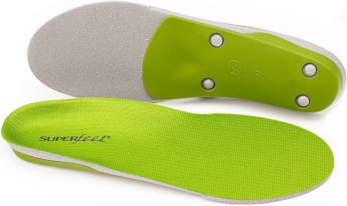
When Do You Need Aftermarket Insoles for Soccer Cleats?
If your soccer cleats feel great—until the 30th minute when your feet start screaming—you’re not alone. Most stock insoles that come with soccer cleats are thin, flat, and wear out quickly, offering little more than a barrier between your foot and the soleplate. For serious players, that’s simply not enough.
Soccer involves constant lateral cuts, sprints, quick stops, and explosive pivots—all of which place high stress on your feet. Without proper support, this can lead to fatigue, arch collapse, heel pain, and even long-term overuse injuries. Aftermarket insoles step in where stock ones fall short.
Here’s when you should consider upgrading:
- You feel pain or fatigue in your arches, heels, or forefoot after games or practice.
- Your cleats lack cushioning or support, especially if you’re playing on firm or artificial surfaces.
- You have high arches, flat feet, or a history of foot-related issues like plantar fasciitis or metatarsalgia.
- You need better shock absorption and alignment to minimize strain on joints during high-intensity play.
Aftermarket insoles offer a range of benefits that can transform your performance and comfort:
- Reduced fatigue and pressure on the metatarsals
- Improved foot alignment for better balance and agility
- Enhanced shock absorption to protect joints during repetitive impact
- Longer-lasting comfort for training sessions, tournaments, or back-to-back matches
If your cleats aren’t doing your feet any favors, a quality insole can be the game-changing upgrade you didn’t know you needed.

What to Look for in Insoles for Soccer Cleats
Not all insoles are created equal—especially when it comes to soccer cleats, where space is tight and performance is everything. The right insole can provide much-needed support and comfort without interfering with the fit or feel of your cleats. Here’s what to look for:
- Low-Profile Design: Soccer cleats are built for close contact with the ground and ball, so there’s not much extra room inside. Look for an insole that’s slim and lightweight—thick or bulky insoles can crowd the shoe, affect fit, and even cause pressure points.
- Arch Support: Whether you have flat feet or high arches, arch support is essential for maintaining proper foot alignment and reducing fatigue. A contoured insole that matches your arch type can help distribute pressure more evenly and reduce the risk of injury.
- Heel Cup: A deep heel cup stabilizes the rearfoot during sudden stops, pivots, and directional changes. It helps lock your heel in place for better control, but make sure it’s not too bulky—cleats with a snug fit may not accommodate extra depth.
- Forefoot Cushioning: The front of the foot takes a beating during soccer—whether you’re sprinting, pushing off, or absorbing impact from firm ground. Good forefoot cushioning protects the metatarsals and enhances responsiveness during explosive movements.
- Grip or Anti-Slip Bottom: You don’t want your insole shifting during a match. Look for insoles with a textured or tacky underside that helps them stay securely in place inside the cleat, even during fast-paced play.
- Durability: Soccer involves constant pressure, moisture from sweat, and abrupt directional movements. A quality insole should be able to withstand the wear and tear of practices, matches, and everything in between—without breaking down or flattening out.
Choosing the right insole for your cleats is about striking a balance between support, comfort, and fit. With the right features, an insole can give your game—and your feet—a serious upgrade.
The Best Insoles for Soccer Cleats (2025)
Here’s a list of the best insoles for soccer cleats (in no particular order):
Spenco RX Orthotics
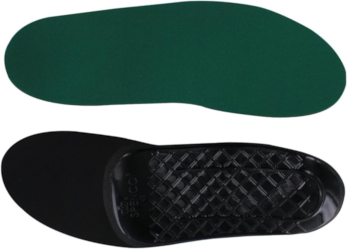
The Spenco RX Full-Length Orthotic is a performance-oriented insole engineered for athletes who demand enhanced support and shock absorption without sacrificing cleat compatibility. Featuring a low-profile construction with a modest 4 mm heel-to-toe drop, it closely mimics the dimensions of factory athletic insoles—making it ideal for use in soccer cleats, where space is limited and ground feel is critical.
Despite its slim profile, the RX Orthotic delivers advanced impact protection through a combination of a lightweight EVA foam base and Spenco’s proprietary SpenCore® cushioning system. This dual-density configuration effectively disperses ground reaction forces during high-impact activities such as sprinting, cutting, and sudden directional changes, helping to reduce stress on the foot and lower limb joints.
The insole incorporates a dynamic, moldable arch support made from flexible TPU, which adapts to the natural contours of the foot. This design promotes midfoot stability, encourages neutral alignment, and helps reduce muscular fatigue during prolonged play or training by supporting the longitudinal arch throughout the gait cycle.
For full-foot support, the RX Orthotic provides biomechanically consistent cushioning from heel to forefoot, enabling even load distribution and minimizing localized pressure on vulnerable areas like the metatarsals or plantar fascia. The insole also includes a textured anti-slip top cloth that enhances traction against the sock liner—minimizing in-shoe slippage and improving overall fit security within the cleat.
Engineered for durability and performance, the Spenco RX Full-Length Orthotic is a highly effective upgrade for soccer players seeking improved comfort, foot alignment, and shock attenuation—without compromising cleat responsiveness or lockdown fit.
SHOP ON AMAZONSpenco RX Full Arch Cushion
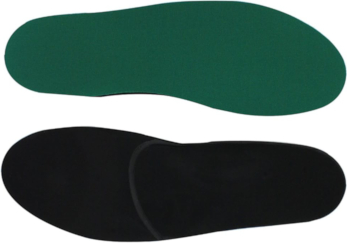
The Spenco RX Full Arch Cushion is a high-performance insole engineered to deliver full-length plantar support and comfort for athletes and active individuals prone to foot fatigue, arch strain, or impact-related discomfort. Designed with comprehensive shock management in mind, it features Spenco’s proprietary SpenCore® cushioning system—a closed-cell EVA and polyurethane blend optimized for impact attenuation, pressure dispersion, and energy return. This dual functionality not only improves comfort but also helps reduce cumulative stress on the foot, ankle, knees, and lower back during high-intensity or prolonged activity.
With a low-profile 4 mm heel-to-toe drop, the RX Full Arch Cushion maintains a thickness and geometry closely aligned with most soccer cleat insoles and performance footwear, ensuring a seamless fit without compromising cleat lockdown, foot control, or ground responsiveness.
At its core, a flexible arch support structure is engineered to conform to the medial longitudinal arch, offering dynamic guidance through the gait cycle. This promotes better midfoot stability, improves biomechanical alignment, and minimizes compensatory motion patterns that can lead to overuse injuries such as shin splints or plantar fasciitis—especially in individuals with high arches or supination tendencies.
The top layer is lined with a grippy, anti-slip surface to reduce internal foot movement during quick directional changes, sprints, or lateral cuts. Infused with antimicrobial agents, the fabric also works to prevent odor buildup and bacterial growth, while reducing shear forces that commonly cause blisters and hot spots during high-friction activity.
SHOP ON AMAZONSpenco PolySorb Cross Trainer
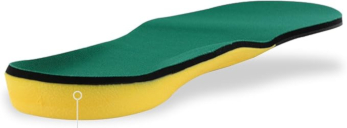
For athletes seeking an insole that combines advanced shock absorption with responsive energy return, the Spenco PolySorb Cross Trainer stands out as a high-performance option—particularly well-suited to the explosive, multidirectional demands of soccer. Originally developed for cross-training environments, its versatile design translates seamlessly to cleats, where cushioning, stability, and proprioception are critical.
The core of the insole features PolySorb polyurethane foam, a high-rebound material engineered to deliver consistent energy restitution and attenuate repetitive impact forces during running, jumping, and abrupt changes in direction. This reduces plantar fatigue and promotes sustained foot efficiency throughout long matches or high-volume training sessions.
To complement its responsive midsole layer, the insole integrates a SpenCore heel plug, strategically placed in the rearfoot to absorb and disperse high-impact shock at heel strike—one of the most critical moments for joint loading in soccer. This feature enhances rearfoot stability and helps protect the calcaneus and subtalar joint from repetitive stress.
The low-profile design—with a 4 mm heel-to-toe drop—ensures that the insole maintains compatibility with tight-fitting soccer cleats, preserving the shoe’s original volume, touch sensitivity, and ground feel, all essential for performance and control. The insole’s slim geometry allows it to enhance comfort and support without introducing bulk or compromising cleat lockdown.
From a biomechanical perspective, the Spenco PolySorb Cross Trainer promotes neutral foot alignment by supporting the medial arch and stabilizing the rearfoot, helping to reduce excess pronation or supination that could contribute to overuse injuries, lateral instability, or joint discomfort.
SHOP ON AMAZONSpenco PolySorb Walker/Runner
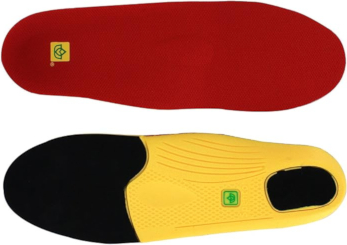
The Spenco PolySorb Walker/Runner insole is designed to deliver targeted plantar support and responsive cushioning, making it a strong choice for soccer players seeking improved comfort, alignment, and shock absorption on the field. Built with a low-profile construction and a 4 mm heel-to-toe drop, it integrates seamlessly into tight-fitting soccer cleats while promoting efficient foot strike mechanics and biomechanically sound gait alignment during high-intensity activity.
At its core, the insole utilizes a dual-layer system combining a SpenCore cushioning layer and a PolySorb polyurethane foam base. The SpenCore layer is engineered to attenuate high-impact forces—particularly during heel strikes—by dispersing shock across a broader surface area, reducing localized pressure on the calcaneus and lower limb joints. This is further enhanced by a SpenCore Heel Plug, a denser foam insert in the rearfoot that provides reinforced impact protection and rearfoot stability during abrupt decelerations, landings, and directional changes common in soccer.
The contoured PolySorb foam layer delivers adaptive, dynamic arch support, stabilizing the medial longitudinal arch and promoting even load distribution across the plantar surface. This helps prevent overuse-related fatigue and supports consistent energy transfer during sprints, lateral movements, and push-offs.
The top cover is constructed with an anti-slip, friction-reducing fabric infused with antimicrobial agents. This surface reduces shear forces that lead to blister formation, helps control moisture and odor, and enhances in-shoe security—keeping the insole firmly in place throughout prolonged periods of play.
SHOP ON AMAZONSuperfeet Premium Berry
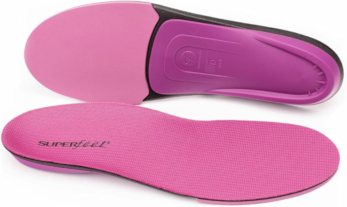
The Superfeet Premium Berry insole is a high-performance, full-length orthotic specifically engineered to deliver enhanced shock attenuation and plantar stability, making it well-suited for female athletes who train or compete on firm, unforgiving playing surfaces. Designed with a low-profile construction, it fits comfortably inside tight athletic footwear—including soccer cleats—without compromising fit or ground feel.
Tailored to the biomechanical structure of the female foot, the insole features a narrower heel and a slightly shallower arch profile to provide a more anatomically accurate fit. This design helps to optimize weight distribution, improve plantar alignment, and reduce compensatory stress on the ankles, knees, and hips—supporting healthier movement throughout the entire kinetic chain.
At the rearfoot, a reinforced deep heel cup securely cradles the calcaneus, improving heel stability and shock control during high-impact phases of play such as sprinting, cutting, or landing. This structure not only reduces the risk of ankle misalignment but also enhances overall balance and rearfoot support.
The high-density closed-cell foam used in the Superfeet Berry offers consistent energy absorption and retains its cushioning properties under prolonged use—unlike softer foams that compress over time. This durable foam formulation helps protect the foot from repetitive stress and contributes to long-term musculoskeletal relief, particularly for those prone to heel pain, plantar fasciitis, or arch fatigue.
To further support comfort and hygiene, the insole is equipped with advanced antimicrobial and odor-control technology, embedded within the top cover to prevent bacterial buildup, reduce odor, and resist moisture—a critical feature for athletes involved in extended training sessions or back-to-back games.
SHOP ON AMAZONSuperfeet Carbon
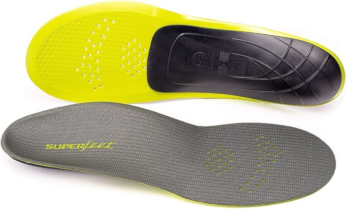
For athletes seeking a low-profile, precision-contoured insole, the Superfeet Carbon stands out as an elite performance option. Designed with an ultrathin profile to maintain a close-to-ground feel, it incorporates a reinforced carbon fiber and polymer blend stabilizer cap, engineered to increase torsional rigidity and medial-lateral control—key for reducing overpronation and managing biomechanical issues such as plantar fasciitis and Achilles tendon strain.
The high-density, closed-cell foam top layer offers lightweight, responsive cushioning while preserving the snug fit required in low-volume footwear like soccer cleats. Anatomically shaped to cradle the heel and align the foot, the Superfeet Carbon promotes more efficient energy transfer and improved biomechanics during lateral cuts, sprints, and sustained play. Its compatibility with cleats featuring removable sockliners ensures a tailored fit without compromising foot sensitivity or field responsiveness.
SHOP ON AMAZONSuperfeet Premium Green
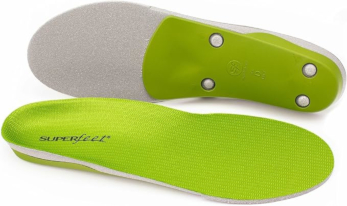
The Superfeet Premium Green insole is a top-tier orthotic solution engineered specifically for individuals with high arches, rigid foot structures, and supination-prone gait patterns. Designed to accommodate a wide range of foot shapes—including wide-footed soccer players—it is available in multiple width and size options for a precise, performance-driven fit. At its core is a high-density foam layer paired with a rigid, full-length stabilizer cap, delivering exceptional arch integrity and rearfoot control during high-intensity play.
A deep, structured heel cup securely cradles the calcaneus, helping to center the heel during ground contact and enhance shock dispersion across the subtalar joint—a critical factor for players who experience repeated heel strikes on firm playing surfaces. The insole also improves medial-lateral stability by guiding the foot through a more neutral loading pattern, thereby reducing stress on the plantar fascia, peroneal tendons, and lateral ankle complex.
Constructed with durable closed-cell foam, the Green insole attenuates repetitive impact forces associated with sprinting, cutting, and directional changes, while maintaining long-term shape retention and support under pressure. This combination of structure and shock absorption reduces muscle fatigue and helps prevent common overuse injuries such as lateral shin splints, iliotibial band syndrome, and fifth metatarsal strain—making it an excellent choice for athletes seeking stability without excess bulk.
SHOP ON AMAZONSuperfeet Premium Orange
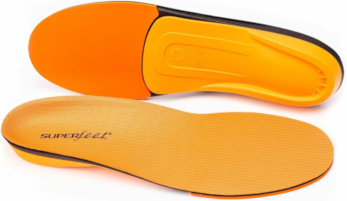
The Superfeet Premium Orange insole is specifically engineered for athletes who endure high-impact, high-intensity movements, such as those encountered on the soccer field. Built for rigorous athletic performance, it features a reinforced forefoot shock pad made from high-density impact-dampening foam, strategically positioned to absorb ground reaction forces during explosive toe-offs, sprints, and abrupt directional changes.
A deep, narrow-profile heel cup cradles the calcaneus, promoting rearfoot alignment and enhancing subtalar joint stability. This structural design not only manages repetitive heel strikes on firm surfaces but also improves proprioceptive control, reducing the risk of strain-related injuries in the ankle and lower limb.
The insole’s full-length closed-cell foam construction provides long-lasting cushioning and structural integrity, distributing pressure evenly across the plantar surface. This helps mitigate plantar fatigue, midfoot collapse, and arch strain during prolonged training sessions or match play. The semi-rigid stabilizer cap embedded beneath the arch reinforces biomechanical alignment, supporting proper foot posture under load.
To enhance hygiene and comfort, the Orange insole integrates advanced antimicrobial treatments and odor-control technology, which inhibit bacterial growth and maintain foot freshness during extended wear in moisture-prone athletic environments. Ideal for athletes seeking responsive cushioning, shock attenuation, and biomechanical efficiency, the Superfeet Orange is built to maximize energy return and minimize lower limb stress under the demands of competitive sport.
SHOP ON AMAZONHow to Fit Insoles into Soccer Cleats
Fitting aftermarket insoles into your soccer cleats isn’t as simple as dropping them in—especially when space is limited and performance is everything. Here’s how to do it right to avoid discomfort, pressure points, or unwanted bulk during play:
1. Remove the Stock Insole
Start by gently peeling out the stock insole that came with your cleats. Most are lightly glued in or just resting in the shoe. Removing it not only makes room for your new insert but also ensures that you’re not layering materials, which could alter your foot’s position and create pressure points.
2. Trim-to-Fit: Be Precise
Many performance insoles come with a trim-to-fit design. To get the perfect cut:
- Use the original insole as a template. Place it on top of the new insole and trace the outline with a pen or marker.
- Cut conservatively. Start slightly outside the traced line and trim gradually. You can always cut more, but you can’t add it back.
- Focus on toe and forefoot areas. These are usually the tightest parts of a soccer cleat and the most sensitive to excess material.
Tip: Check the fit by placing the insole inside the cleat before making final trims. It should lie flat without buckling or curling at the edges.
3. Check for Fit and Bulk
After inserting the trimmed insole, slip your foot in. It should feel snug but not cramped. Watch out for:
- Raised heel or arch height that causes your heel to lift too high.
- Toe crowding that leads to black toenails or blisters.
- Bunched-up edges that may cause friction.
If it feels too tight or alters your foot placement dramatically, the insole might be too bulky for your cleats. Opt for a low-profile or slim-design insert specifically made for cleats if needed.
4. Break-In Period: Know What to Expect
Even the best insole might feel “different” during your first few sessions. To ease the transition:
- Expect slight stiffness if the insole has a rigid arch or stabilizer cap—it will conform to your foot over time.
- Listen to your feet. Discomfort should diminish after 2–3 wears. Persistent pain or hotspots? It’s a sign the insole isn’t the right fit or needs further trimming.
5. Avoiding Pressure and Blisters
Soccer cleats are designed to be glove-like, so extra bulk can easily backfire:
- Use thin socks during the fitting process to better gauge the internal volume.
- Avoid insoles with thick forefoot pads or excessive arch build-up unless your cleat has room.
- Monitor for any rubbing at the heel, arch, or toes during lateral cuts or sprints.
With the right fit, your upgraded insoles should offer more support, better shock absorption, and fewer foot issues—without compromising your feel for the ball or agility on the pitch.
Best Insoles for Soccer Cleats FAQs
How do insoles improve comfort and performance in soccer cleats?
Insoles provide additional arch support, shock absorption, and cushioning, which help reduce foot fatigue and enhance stability, ultimately improving overall performance during play.
Can using insoles prevent injuries while playing soccer?
Yes, using quality insoles can help mitigate the risk of injuries by providing better arch support and alignment, reducing stress on the feet and lower limbs during intense activities.
Are custom insoles worth the investment for soccer players?
Custom insoles can be worth the investment as they are tailored to fit individual foot shapes and specific needs, offering enhanced support and comfort that may not be available with off-the-shelf options.
How often should I replace the insoles in my soccer cleats?
It is recommended to replace insoles every 6 to 12 months, or sooner if they show signs of wear and tear, to maintain optimal support and comfort during play.
Can I use running insoles in soccer cleats?
Yes—but with caution. Running insoles can offer excellent arch support and shock absorption, but many are too thick or bulky for the snug fit of soccer cleats. Look for low-profile, trim-to-fit designs that won’t crowd your toes or elevate your heel too much. Avoid cushy or high-stack models that reduce ground feel and ball control. If a running insole fits flush and doesn’t create pressure points, it can work—just make sure to test it during short sessions first and watch for discomfort or reduced mobility.
Do Insoles Affect Ball Feel or Performance?
Yes, insoles can affect both ball feel and on-field performance, depending on their design. Thicker or heavily cushioned insoles may reduce ground feel and touch sensitivity, which are crucial for precise dribbling and control. On the other hand, well-fitted, low-profile insoles can enhance comfort, support, and stability without compromising touch. For players with foot pain or alignment issues, the right insole can actually improve performance by reducing fatigue and injury risk. The key is finding an insole that supports your foot without adding unwanted bulk or altering your natural movement.
How Often Should You Replace Insoles?
Most insoles should be replaced every 6 to 12 months, depending on how often you play, your body weight, and the intensity of use. Signs it’s time for a replacement include flattened cushioning, loss of arch support, bad odor, or new discomfort or pain. Athletes using insoles in soccer cleats or running shoes may need to replace them more frequently—every 300–500 miles or after a season of regular play. If the insole no longer feels supportive or starts to wear unevenly, it’s time for a fresh pair.
Are Custom Orthotics Better for Soccer?
Custom orthotics can be better for soccer players with chronic foot issues, biomechanical imbalances, or a history of injury, as they’re tailored to your exact foot shape and gait. They offer precise support, alignment, and pressure relief, which can improve performance and reduce injury risk. However, they’re also expensive and may be overkill for players with neutral feet or no pain. High-quality over-the-counter insoles designed for cleats can often provide excellent support at a lower cost. Bottom line: custom is best for complex foot needs, but not necessary for everyone.
Should Youth Players Wear Aftermarket Insoles?
Yes, but only when needed. Youth players with flat feet, high arches, or recurring foot pain may benefit from aftermarket insoles that offer better support, shock absorption, and alignment than standard cleat insoles. However, it’s important to choose low-profile, flexible models that don’t interfere with natural foot development. For most young athletes with healthy feet, stock insoles are usually sufficient. Always consult a podiatrist if there are signs of persistent discomfort, imbalance, or overuse injuries before using structured orthotics.
Final Thoughts On the Best Insoles for Soccer Cleats
The right insole can do more than just cushion your steps—it can transform your game. Whether you’re battling foot fatigue, seeking better support, or just looking for a more comfortable ride in your cleats, the right insert can enhance performance, stability, and injury prevention on the pitch.
Remember, there’s no one-size-fits-all solution. Experiment based on your foot type, playing style, and position—what works for a center back may not suit a winger. Try different profiles and support levels until you find your ideal match.
Final tip: A great cleat gives you traction. The right insole gives you control. Together? They’re a game-changer.
You may also like:
